6-2 Many terrestrial world surfaces are dominated by impact craters revealing the age of underlying processes
Probably one of the first things an observer notices about our Moon is that it is pockmarked with circular depressions. The same is true for many of the images of terrestrial planets and other moons. But where do these circular craters come from, and how do they change a planetary landscape?
What Creates an Impact Crater?
 Go to Video 6-1
Go to Video 6-1
When the Bavarian astronomer Franz von Gruithuisen proposed in 1824 that the craters seen on the Moon could be the result of impacts from flying space debris, a major problem for his theory was the observation that nearly all craters are round. If craters were merely gouged out by high-speed rocks, a rock striking the Moon in any direction except straight downward would have created a noncircular crater, which is different from what we observe. A century after Gruithuisen, it was realized that a high-speed impactor colliding with the Moon generates a shock wave in the lunar surface that spreads out evenly from the point of impact. Perhaps surprisingly, this type of shock wave produces a nearly perfectly circular crater no matter in what direction or impact angle the incoming impactor comes from. Many of the largest lunar craters have a central peak rising up from the crater floor, which is characteristic of a high-speed impact (Figure 6-2a). Craters made by other processes, such as volcanic action, would not have central peaks of this kind. But what object could create such a crater?
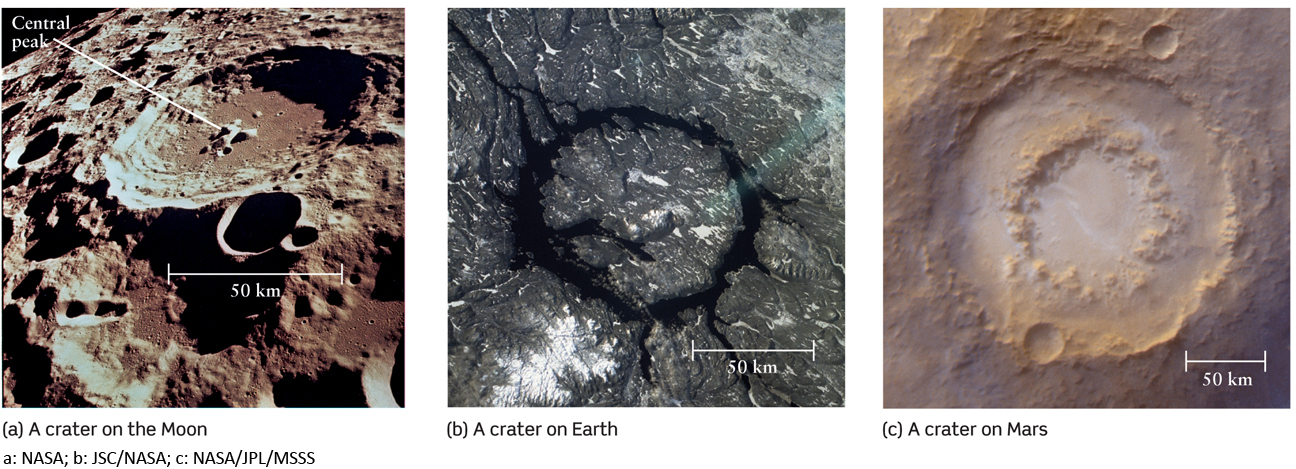
The planets orbit the Sun in nearly circular orbits (see Figure 4-1), but many asteroids and comets follow more elongated orbits. These elongated orbits can put these small objects on a collision course with a planet or moon. If an object collides with a Jovian gas-planet, it is swallowed up by the planet’s thick atmosphere. (Astronomers actually saw an event of this kind in 1994, when a comet crashed into and was swallowed up by Jupiter, with all traces of impact disappearing after a few months.) But when an object collides with the solid surface of a terrestrial planet or a moon, the result is an impact crater (see Figure 6-2). Such impact craters, found throughout the solar system, offer stark evidence of these violent collisions.
144
Question
ConceptCheck 6-2: What shape of crater will a potato-shaped impactor, 30 km long and 10 km wide, make if it collides with Earth and impacts at a low angle?
Cratering Measures Geologic Activity
Not all planets and moons show the same amount of cratering. The Moon is heavily cratered over its entire surface, sometimes with craters on top of older craters on top of even older craters, as shown in Figure 6-2a. On Earth, by contrast, craters seem to be very rare: Geologists have identified fewer than 200 impact craters on our planet (Figure 6-2b). Our understanding is that the Moon formed almost immediately after the formation of Earth, and the Moon and Earth have been bombarded at comparable rates over their history. Why, then, are craters so much rarer on Earth than on the Moon?
The answer is that Earth is a geologically active planet. Because of plate tectonics, the continents slowly change their positions over eons. New material flows onto the surface from the interior in volcanic eruptions or from seafloor spreading, and old surface material is pushed back into the interior. These processes, coupled with erosion from wind, water, and ice, cause craters on Earth to be erased over time. The few craters found on Earth today must be relatively recent, since there has not yet been time to erase them.
The Moon, by contrast, is essentially geologically inactive. There are no volcanoes and no motion of continental plates (and, indeed, no continents). Furthermore, the Moon has neither oceans nor an appreciable windy and weather-carrying atmosphere, so there is little obvious erosion as we know it on Earth. With none of the processes that rapidly erase evidence of craters on Earth, the Moon’s surface remains largely unchanged—pockmarked with the scars of billions of years of impacts.
All terrestrial planets and moons have impact craters, and heavily cratered areas are found on the oldest, least changed surfaces.
As we saw in Chapter 5, in order for a planet to be geologically active, its interior must be at least partially molten, so that continental plates can slide around on the underlying mantle and so that molten lava can come erupting up to the planet’s surface (see Figure 5-10). So, we would expect geologically inactive—and hence heavily cratered—worlds like the Moon to have less molten material in their interiors than does Earth. Investigations of these inactive worlds bear this out. But why is the Moon’s interior less molten than Earth’s?
ANALOGY
To see one simple answer to this question, notice that a large turkey or roast taken from the oven will stay warm inside for hours, but a single meatball will cool off much more rapidly. The reason is that the meatball has more surface area relative to its volume, so it more easily loses heat to its surroundings. A planet or satellite also tends to cool down as it emits electromagnetic radiation into space; the smaller the planet or satellite, the greater its surface area relative to its volume, and the more readily it radiates away heat (Figure 6-3). Both Earth and the Moon were probably completely molten when they first formed, but because the Moon (diameter 2160 mi or 3476 km) is so much smaller than Earth (diameter 7918 mi or 12,742 km), it has lost much of its internal heat and has a much more solid interior.
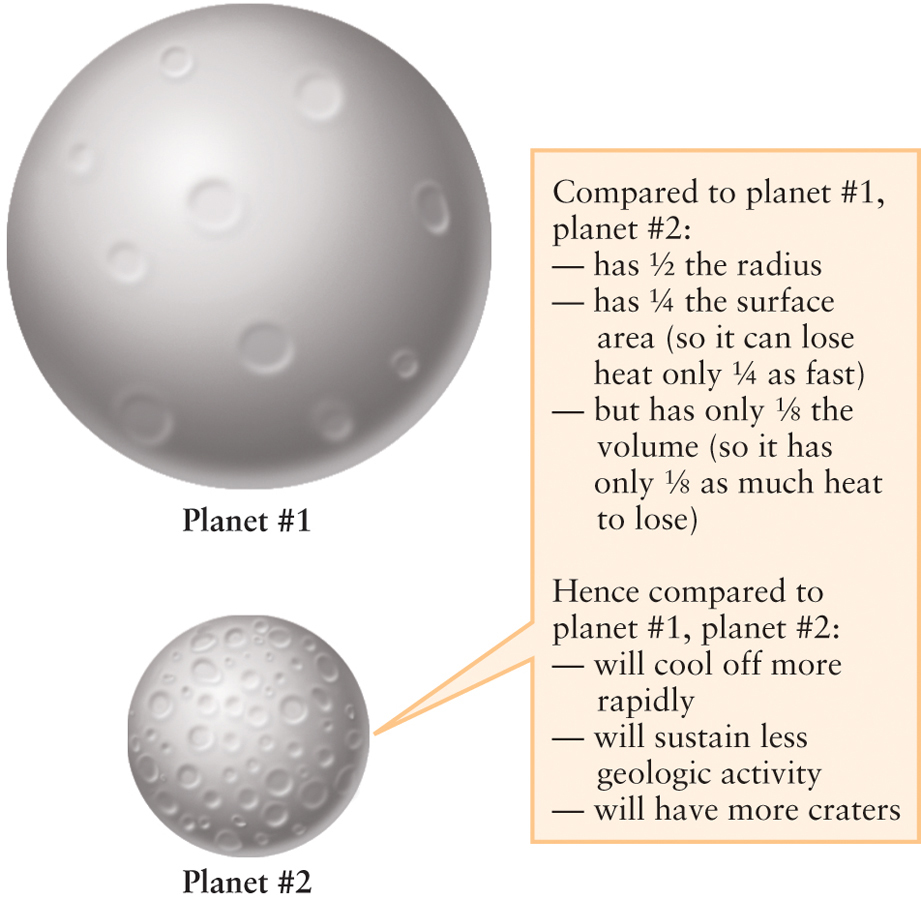
By considering these differences between Earth and the Moon, we have uncovered a general rule for worlds with solid surfaces:
The smaller the terrestrial world, the less internal heat it is likely to have retained from its formation, and, thus, the less geologic activity it will display on its surface. The less geologically active the world, the older and more heavily cratered its surface.
This rule means that we can use the amount of cratering visible on a planet or satellite to estimate the age of its surface and how geologically active it is.
As for all rules, there are limitations and exceptions to the rule relating a world’s size to its geologic activity. One limitation is that the four terrestrial planets all have slightly different compositions, which affects the types and extent of geologic activity that can take place on their surfaces. This also complicates the relationship between the number of craters and the age of the surface. An important exception to our rule is Jupiter’s satellite Io, which we will discuss in more detail later in the chapter (see Box 6-1 The Heavens on Earth: Jupiter’s Moon Io Is Covered with Active Volcanoes). Despite its small size, it is the most volcanic world in the solar system. And in spite of these limitations and exceptions, the relationships between a world’s size, internal heat, geologic activity, and amount of cratering are powerful tools for understanding the terrestrial planets and satellites. Let’s take a look at cratering on our Moon and the inner planets.
145
The History of Lunar Cratering
By correlating the ages of Moon rocks with the density of craters at the sites where the rocks were collected by NASA astronauts, geologists have found that the rate of impacts on the Moon has changed dramatically over the ages. The ancient, heavily cratered lunar highlands are evidence of an intense bombardment that dominated the Moon’s early history. For nearly a billion years, rocky debris left over from the formation of the planets rained down upon the Moon’s young surface. As Figure 6-4 shows, this barrage extended from 4.56 billion years ago, when the Moon’s surface solidified, until about 3.8 billion years ago. At its peak, this bombardment from space would have produced a new crater of about 1 mi (1.6 km) radius somewhere on the Moon about once per century. If this seems like a long time interval, remember that we are talking about a bombardment that lasted hundreds of millions of years and produced millions of craters over that time. Many of these impacts could have brought tiny amounts of water to the Moon, adding up over many millions of years to a tremendous amount of water, which could still present today as ice, hidden in the permanently shadowed walls of deep craters near the Moon’s poles.
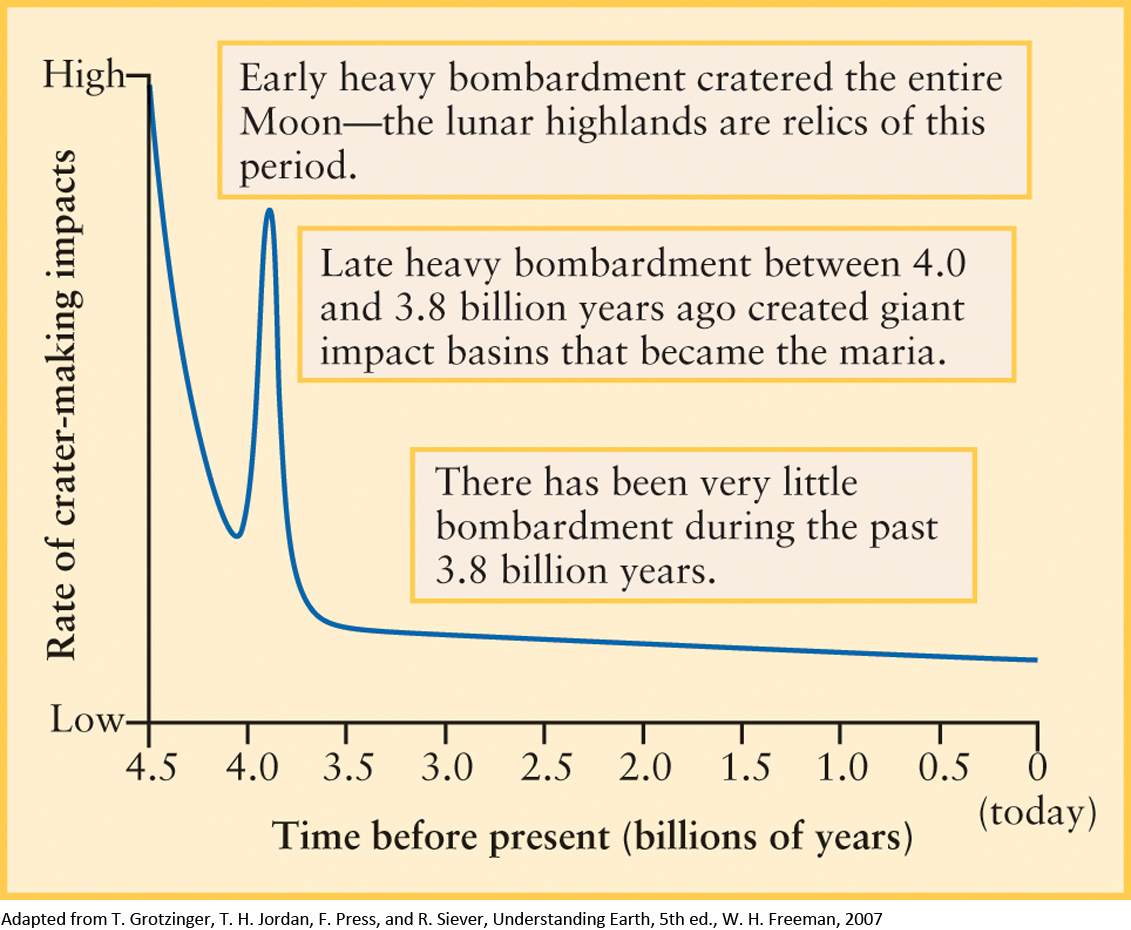
The rate of impacts should have tapered off as small debris left over from the formation of the solar system was swept up by the newly formed planets. In fact, radioactive dating shows that the impact rate spiked upward between 4.0 and 3.8 billion years ago (see Figure 6-4). One proposed explanation is that the much larger orbits of Jupiter and Saturn changed slightly but suddenly, about 4.0 billion years ago during the process of settling into their present-day orbits. This would have changed the gravitational forces that these planets exerted on the asteroid belt, disturbing the orbits of many asteroids and sending them careening toward the inner solar system.
Whatever the explanation for the final epoch of heavy bombardment, major impacts during this period gouged out the mare basins. Between 3.8 and 3.1 billion years ago iron-rich magma oozed up from the Moon’s still-molten mantle, flooding the Moon’s smooth dark basins with lava that solidified to form the dark rocks we see on the surface. Figure 6-5 shows rugged terrain created by craters on the Moon, some of which has been smoothed by upwelling lava, whereas other more rugged areas create permanent shadows harboring frozen water ice.

Question
ConceptCheck 6-3: How would a graph showing the rate of crater formation on the Moon appear if the Moon’s impact rate had instead been constant over the past 3 billion years?
 Go to Video 6-2
Go to Video 6-2
Mercury’s Cratered Surface On first glance, the planet Mercury might look nearly identical to pictures you have seen of the Moon. Figure 6-6 shows a typical close-up view of Mercury, confirming that it indeed looks quite a bit like Earth’s Moon. Unlike the Moon, Mercury’s surface has extensive low-lying plains (examine the left half of Figure 6-6). These large, smooth areas probably have an origin similar to our Moon’s smooth basins, where primordial lava flows smoothed the surface. As large impactors punctured the planet’s thin, newly formed crust, lava welled up from the molten interior to flood low-lying areas and erase evidence or earlier craters.
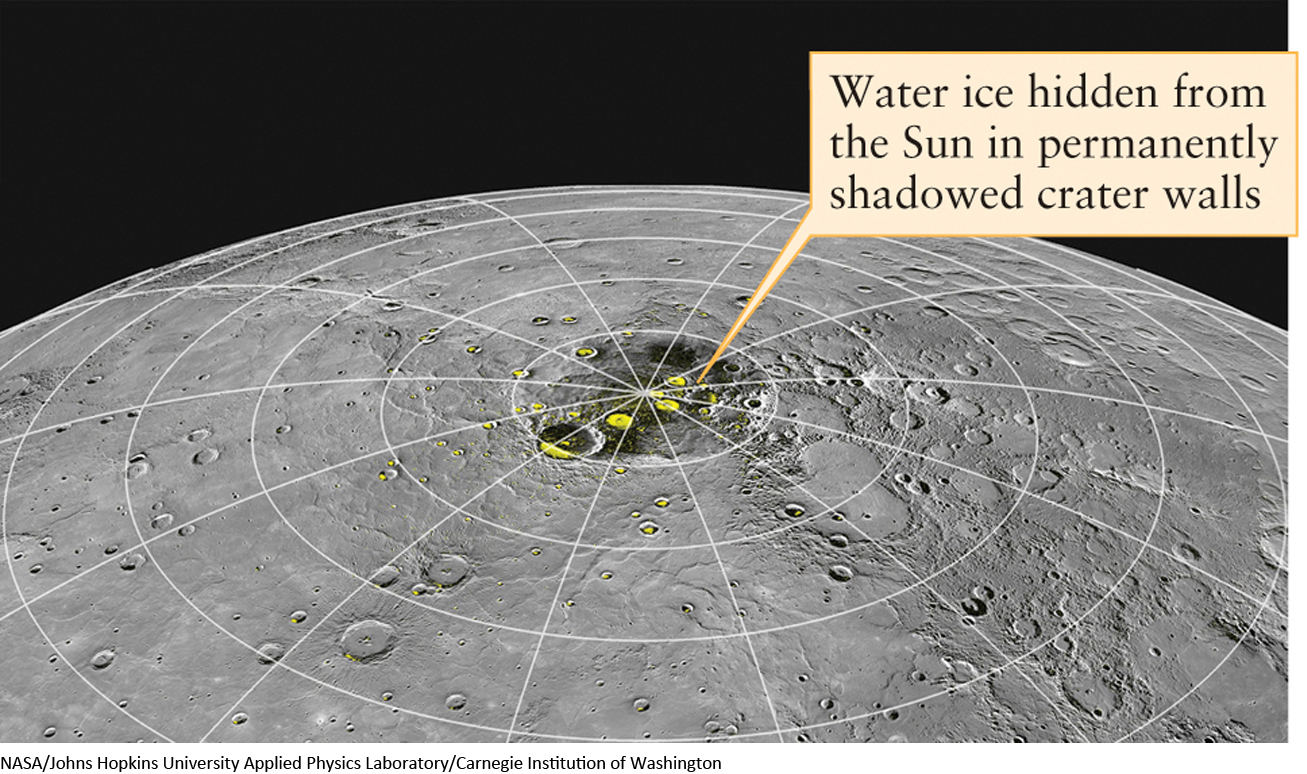
146
At the same time, we find deep crater walls in shadow regions that rarely are bathed in sunlight. These shadow regions can serve as protective areas for frozen water ice to remain on Mercury indefinitely, even with its surface’s tremendously high temperatures due to its nearness to the Sun. In recent years, radar observations have detected patches at Mercury’s north and south poles that are unusually effective at reflecting radio waves. If these observations are correct, then Mercury is truly a world of extremes, with perpetual ice caps at one or both poles but then midday temperatures at the equator that are high enough to melt lead. Spacecraft have also revealed numerous long cliffs, called scarps or rupes, meandering across Mercury’s surface and disrupting craters dotting the landscape (Figure 6-7). Some scarps rise as much as 2 mi (3 km) above the surrounding plains and can be hundreds of miles long. These cliffs probably formed as the planet cooled, cracked, and contracted.
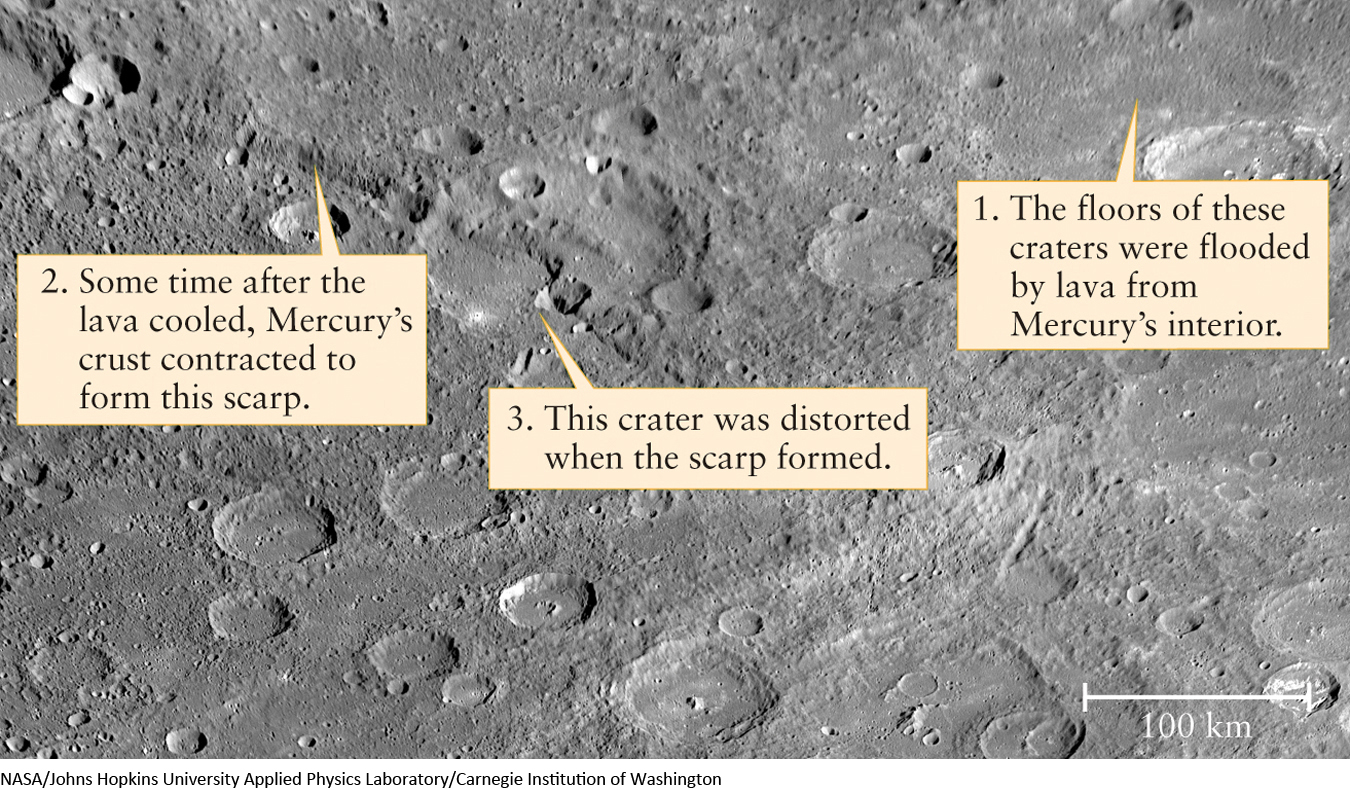
ANALOGY
The shrinkage of Mercury’s crust is probably a result of a general property of most materials: They shrink when cooled and expand when heated. The lid on a jar of jam makes a useful analogy. When the jar is kept cold in the refrigerator, the metal lid contracts more than the glass jar. This makes a tight seal but also makes the lid hard to unscrew. You can loosen the lid by running hot water over it; this makes the metal lid expand more than the glass jar, helping to break the seal.
If there had still been molten material beneath Mercury’s surface when this contraction took place, lava would have leaked onto the surface around the scarps. This does not appear to have happened. Therefore, the scarps must have formed relatively late in Mercury’s history, after the lava flows had ended and after the planet had solidified to a substantial depth beneath the surface. With the exception of the scarps, there are no features on Mercury that resemble the boundaries of tectonic plates. Thus, we can regard Mercury’s crust, like that of the Moon, as a single plate.
Question
ConceptCheck 6-4: What could you infer about the age of the giant and nearly smooth crater on Mercury if instead it was covered with impact craters?
Fewer Craters on Venus and Mars Indicates Geologic Activity On Venus, by comparison, there are only about a thousand craters larger than a few miles in diameter. This is many more than have been found on Earth, but only a small fraction of the large number on the Moon or Mercury. Venus is only slightly smaller than Earth in diameter, and it should have enough internal heat to power the geologic activity required to erase most of its impact craters.
Mars is an unusual case, in that extensive cratering is found only in the higher terrain; the lowlands of Mars are remarkably smooth and free of craters. Thus, it follows that the Martian highlands are quite old, while the lowlands have a younger surface from which most craters have been erased. Considering the planet as a whole, the amount of cratering on Mars is intermediate between that on Mercury and Earth. This agrees with our general rule, because Mars is intermediate in size between Mercury and Earth. The interior of Mars was once hotter and more molten than it is now, so geologic processes were able to erase some of the impact craters. A key piece of evidence that supports this picture is that Mars has a number of immense volcanoes, like the one shown in Figure 6-8. These were active when Mars was young, but as this relatively small planet rapidly cooled down and its interior solidified, the supply of molten material to the volcanoes from the Martian interior was cut off. As a result, all of the volcanoes of Mars are now inactive.
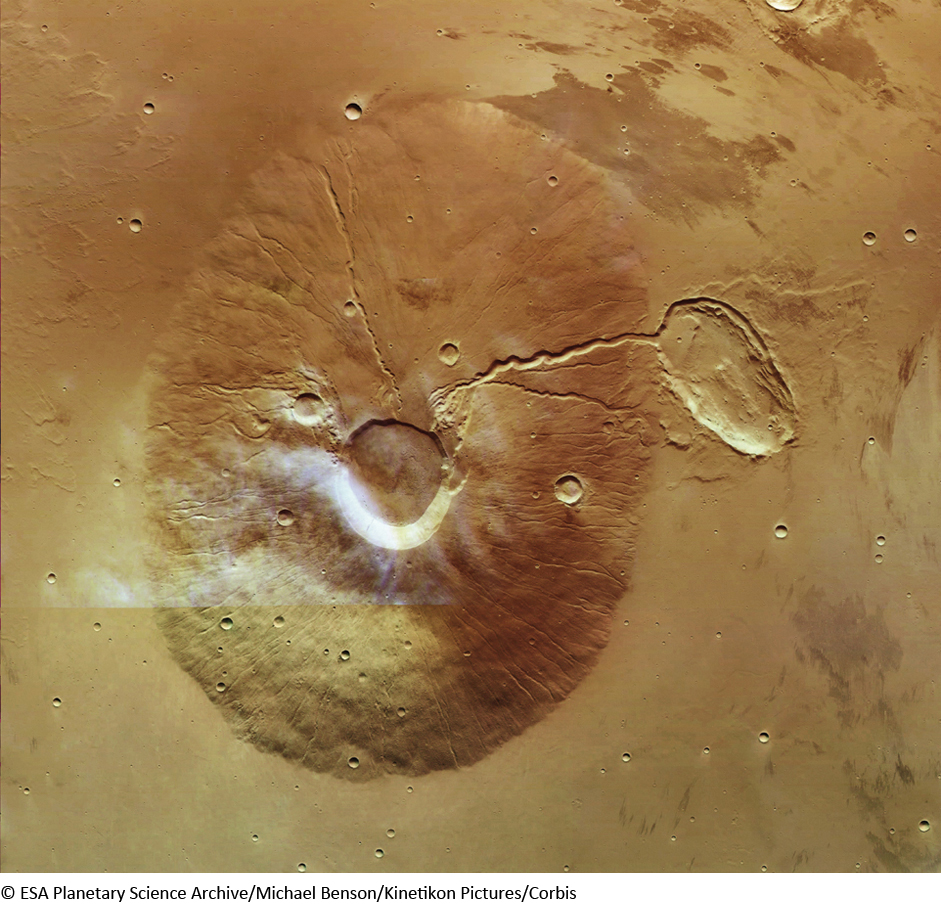
To study Venus and Mars, we need to take a deeper look at volcanism and tectonics on each of these planets.
147
Question
ConceptCheck 6-5: What will happen to the tire tracks left on the Moon in the 1960s and 1970s from the “Moon-buggy” used by U.S. astronauts to explore the Moon?